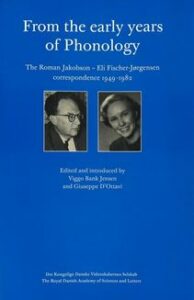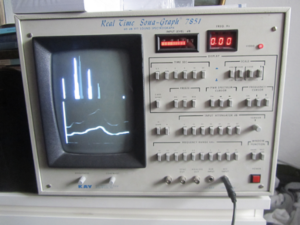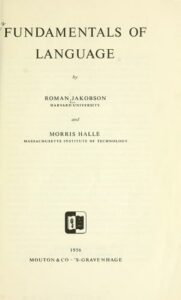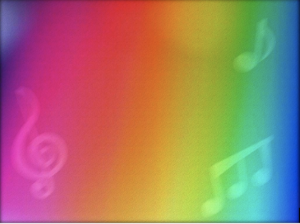In order to trace the history of ideas, we can turn to a number of resources. Sometimes, it is through a scholar’s public words: acknowledgements or references. The latter – in the form of footnotes (Grafton 1997) or indices (Duncan 2021) – have been argued to be where the true academic allegiances and challenges are set out and displayed. However, sometimes the networks of information exchange and influence can be searched for fruitfully in private documents. It is precisely such private documents which make up the resource used in the book From the early years of Phonology. The Roman Jakobson – Eli Fischer-Jørgensen correspondence 1949-1982, edited by Viggo Bank Jensen and Giuseppe D’Ottavi.

The introduction opens with the question underlying the study of this correspondence: why would Roman Jakobson – a ‘Wikipedia-famous’ scholar from Russia, ‘one of the most celebrated and influential linguists of the 20th century’ (p. 12) – keep in touch with Eli Fischer-Jørgensen, a Danish linguist now mainly known in the field of phonetics, 15 years his junior? For example, in Jakobson’s 698-page-long Selected Writings – Phonological Studies (Vol. 1) there are only two citations of Eli Fischer-Jørgensen (compared to 13 for Gunnar Fant). That said, there is of course no doubt about the importance of Eli Fischer-Jørgensen’s contributions – just take a look at the biography reviewed here on Lingoblog three years ago by Peter Bakker. Obituary notices by colleagues (Grønnum et al., Kohler) as well as an encyclopedia entry about her (Gregersen) note her essential work as a critic and her deep knowledge of the field and its members. Nor is it any mystery that Eli Fischer-Jørgensen was drawn to fields opened up by Roman Jakobson (sound symbolism, language development in children). Thus, while Fischer-Jørgensen’s significant work in the field and prominence in phonetics and phonology cannot be questioned, this book does provide a lot of helpful detail on the context and figures in this extensive network – in time and space – to which both belonged. Their correspondence spans a time (1949-1982) when Jakobson was already based in the US, eleven years after they had originally met at the Third International Congress of Phonetic Sciences that had taken place in Ghent in 1938. Their correspondence is nearly entirely in English and begins with Eli Fischer-Jørgensen’s invitation to Roman Jakobson to contribute to a volume dedicated to Louis Hjelmslev’s theory of glossematics.
The book contains the following eight parts:
Part 1: Introduction. Overview of the two figures and their contexts
Part 2: The Roman Jakobson Papers at MIT: an Outlook
Part 3: The Eli Fischer-Jørgensen Papers at the Royal Library of Denmark
Part 4: Editorial principles
Part 5: List of published Letters and Documents giving their unique provenience
Part 6: The Correspondence
Part 7: Bibliography to the Correspondence
Part 8: Name Indexes
Part 1 is very much to be recommended to students starting out in phonetics and phonology as it situates the main scientists in the field and gives concise biographical and research focus information on each of them. The section up to page 18 contains mainly information published elsewhere (e.g. by Grønnum and Gregersen). However, this is where the information added by the letters is also useful – such as showing how Jakobson put Fischer-Jørgensen in touch with scholars such as the leading phonetician from Norway, Gunnar Fant. It is worth noting that not all the letters involve exchanges between Jakobson and Fischer-Jørgensen. They also include, among others, a letter from Jakobson to a publisher, indicating that he wishes Eli Fischer-Jørgensen to write the preface to a collection of his texts. The letters also give clues as to which documents have not survived – for example Jakobson’s correspondence with the Danish linguist Viggo Brøndal (letter 95).

Although not strictly concerned with Jakobson and Fischer-Jørgensen, nor limited to phonology, I found section 1.8 of the introduction essential in understanding references in the letters, since it traces the purpose and history of the various linguistic congresses, schools of thought, circles, and their respective publications, which have changed names and direction over the years. Throughout the introduction there are key diagrams, as well as helpful insets that explain, for example, theories of articulatory and acoustic phonetics – the source-filter model (p. 35). They also relate anecdotes about how scientists collaborate across fields, for example John Ohala’s account of the acoustic phonetician Fant working in 1949 with Jakobson on distinctive features, p. 38).

There are some terms that appear to have escaped the copy editor – such as ‘explosion noise’ (p. 17) for what is better known as ‘release burst’ or ‘plosive release’. However, in terms of readability, there is nothing dry about the style, with warmth and enthusiasm perceptible in all the texts – from the editors to the letter-writers themselves.
Part 8 (Indexes) contains the references to the names that are mentioned in the correspondence as well as those in the prefatory chapters. It does not provide page numbers or other indications of topics dealt with, either in the letters or in the editors’ essays. With this we return to our starting point: namely, the purpose of the index. It is not possible to search the letters for themes or topics. In this sense, it would be desirable to see a digital edition, if possible in open access, on the model of the Hugo Schuchardt Archive in Graz, Austria, or more broadly the services provided by correspSearch (https://correspsearch.net/). Given the intensive work that went into transcribing and annotating the letters, as well as the inherent value of the texts, this correspondence deserves to reach the widest possible audience, and benefit from infrastructure developed in Digital Humanities. In this way, it would be possible for other scholars to gain insights into which topics were discussed, even to ascertain which ones do not appear in the letters, and whether further conclusions may be drawn about the scientific exchange between these two figures. Furthermore, there seems to be no mention of the range of languages Jakobson and Eli Fischer-Jørgensen discuss in the letters, and yet these furnish perhaps some of Fischer-Jørgensen’s most decisive input to RJ’s published works – and not only on Danish. The book’s introduction draws attention to letter 25 from 1952, in which Eli Fischer-Jørgensen advises Jakobson and the American phonetician Morris Halle to use Dutch or German to illustrate the tense/lax distinction rather than French, and the authors point out that Jakobson and Halle did indeed adopt this in their 1956 book Fundamentals of Language, using Dutch vowels.

In the very last section of the introduction, the work done by Fischer-Jørgensen and Jakobson on the history of linguistics is discussed. It focuses mainly on the publication of Fischer-Jørgensen’s major work – Trends in Phonological Theory. A Historical Introduction. Coincidentally – and the section makes no mention of this – Jakobson published his own historiographical work (Trubetzkoy’s letters) that same year, 1975. In fact, the editors do not give any space to Jakobson’s edition of Trubetzkoy, although the work under review has similar stated goals – to investigate the history of phonology and how networks of scholars built up knowledge and theories. However, the editors do make much of Fischer-Jørgensen’s letter from Trubetzkoy, included in Jakobson’s work, which appears to be Trubetzkoy’s last letter before his premature death provoked by the stress of being persecuted for his political stance, but Fischer-Jørgensen herself considers the letter insignificant (letter 78). Concerning the question of their respective roles over time, I found that Jakobson’s reaction to Fischer-Jørgensen’s volume (letter 84) reads like that between two colleagues rather than the hierarchical one which the editors present (mentor-student): Jakobson thanks Fischer-Jørgensen for including his work (the editors note that Eli Fischer-Jørgensen dedicated an entire chapter to theory of distinctive features) and he offers to send her some corrections in the case of a future edition.

Readers will also enjoy the human-interest aspect – Eli Fischer-Jørgensen’s favorite American city was San Francisco (letter 28). Worries about where the next grant might come from and conference location decisions seem to have been just as common and tedious then as they are now. Everyone ends up responding to letters later than intended, and apologies follow familiar paths. The Danish linguist Louis Hjelmslev, one of Fischer-Jørgensen’s professors, appears over 120 times in the letters, including in a song whichFischer-Jørgensen wrote in 1980 on glossematics for the 25th anniversary of the Copenhagen Linguistic Circle.
In comparison to the various other accounts of the history of phonology as a discipline, this book is one of the few to focus on European networks of scholars, and it shifts the focus from the sounds of English to those of other languages. The letters attest to a connection that survived across decades on either side of the Atlantic, in two people who continued to be curious about and interested in what was going on in different circles, and conscious of how scholars of each continent knew or did not know of the research taking place elsewhere. There is also the cautionary example of the allure of quantitative data, with Eli Fischer-Jørgensen (as well as Gunnar Fant) warning Roman Jakobson about using acoustic measurements to suit his theories. And then there is perhaps also the most profound lesson these ‘early years of phonology’ have for us: the importance of scientific exchange across disciplines for the purposes of checking each other’s work in a collegial fashion (a legacy of the linguistic circles), as well as for opening up new areas for research.

Sarah Melker is a research and teaching assistant at the Department of English Studies, University of Graz (Austria), working in syntactic variation as well as history of linguistics. She enjoys the benefits of her training in forensic phonetics everywhere, but especially while stuck waiting in line at the grocery store or post office. Her frequent New Year’s Resolution is to become a more diligent correspondent.
Further reading
Duncan, D. (2021). Index, a history of the: a bookish adventure from medieval manuscripts to the digital age. New York, NY: Norton.
Fischer-Jørgensen, E. (1975). Trends in phonological theory: A historical introduction. Copenhagen: Akademisk Forlag.
Grafton, A. (1997). The footnote: A curious history. Cambridge: Harvard University Press.
Gregersen, F. (2006). Fischer-Jørgensen, Eli (1911- ). In K. Brown (Ed.), Encyclopedia of languages and linguistics. Vol. 4 (pp. 488-488). Amsterdam: Elsevier.
Grønnum, N., Gregersen, F., & Basbøll, H. (2010). Eli Fischer-Jørgensen 1911–2010. Phonetica, 66(4), 251-256.
Hurch, B. (Ed.) (2022). Hugo Schuchardt Archiv. Graz: Institut für Sprachwissenschaft und Zentrum für Informationsmodellierung – Austrian Centre for Digital Humanities, Universität Graz. http://schuchardt.uni-graz.at.
Jakobson, R. (1971). Selected writings: 1. Phonological studies. The Hague: Mouton.
Jakobson, R. (Ed.) (1975). N. S. Trubetzkoy’s letters and notes. The Hague: Mouton.
Kohler, K. J. (2010). In Memoriam: Eli Fischer-Jørgensen (1911-2010). Journal of the International Phonetic Association, 255-259.
Skytte, G. (2016). Eli – 99 års opdagelsesrejse gennem livet. En biografi om sprogforskeren Eli Fischer-Jørgensen (1911-2010) [Eli – 99 years of exploring life. A biography of language researcher Eli Fischer-Jørgensen (1911-2010)]. Copenhagen: The Royal Danish Academy of Sciences and Letters. Reviewed on Lingoblog: https://www.lingoblog.dk/en/eli-fischer-jorgensen-1911-2010/







